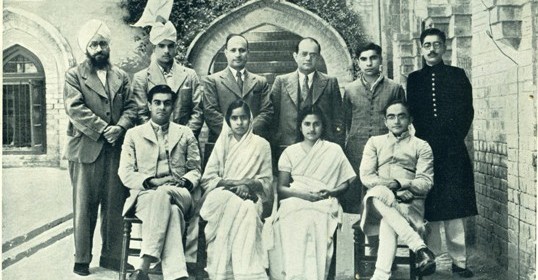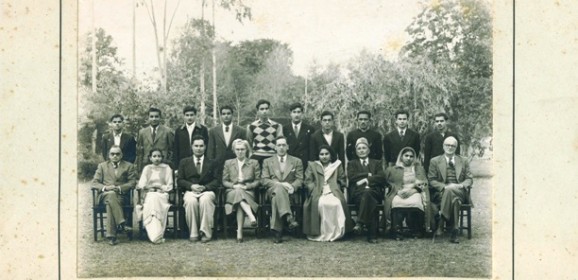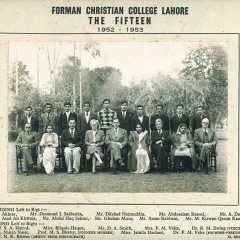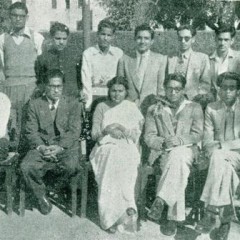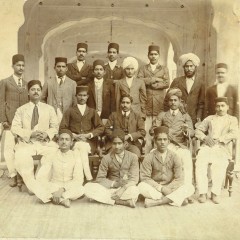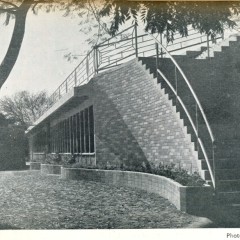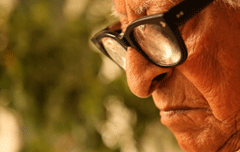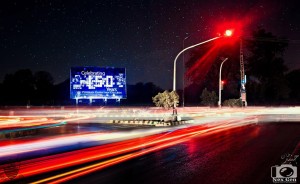The Story of Folio
The Folio can rightly claim to be the oldest college magazine in West Pakistan. Its inaugural issue came out in November 1903. It was then a monthly publication containing about thirty pages. Annual subscription was fixed at Rs. 4 for students of the college and Rs. 3 for members of the Graduates Association, as the Alumni Association was then known. The magazine at that time was known by the simple name of the F. C. College Monthly and it was managed exclusively by the members of the teaching staff, who hastened to assure their readers that the bringing out of this journal was “not an aimless task”. “The college staff,” says an editorial note, “is not suffering in the least from lack of work. All are very busy men but so earnest is their desire to supplement the work of lecture room by perpetuating, in a sense, the relation which they bear to the pupils here that they most cheerfully assume this additional burden.” The staff members in charge of this publication, who chose to remain anonymous, laid down that the policy of the journal shall be “to speak the truth in love and to abstain scrupulously from anything savouring of harshness and uncharitableness in our judgements of opinions of others who honestly differ from ourselves”. This, in the year 1903, must have seemed downright radical. The main aim was, however, confined to enabling old students to keep themselves in touch with the college and its work. Expectations and hopes were realistic and pragmatic rather than enthusiastic. “Should experience prove that we can be helpful to graduates, undergraduates and other English speaking gentlemen of North India, the task now undertaken will be one of very genuine delight.” The magazine, apart from a few articles, contained some regular features like news about old boys, current life of the college, “science” and “notes and comments” which consisted of commentaries on various happenings at home and abroad. In the first issues, there was a note on the Investiture of the Nawab of Bahawalpur. Another ran like this: “We witness with dismay that at parties where Indians are the host and Europeans are guests a liberal supply of intoxicants is provided.” There were also comments upon the struggle in England between Free Traders and the Protectionists, the fact that MA English classes have been started in both F. C. and Government Colleges and “the hope that cordiality will prevail between the two colleges without the objectionable spirit of rivalry”. There was also a small article on Wireless Telegraphy which began: “By improving his ingenuous apparatus, Signor Marconi has made considerable progress in...
An Interview with Jamila Hashmi
Author Jameela Hashmi did her MA in English from Forman Christian College. She started her writing career by contributing to the student magazine Folio. She was a also member of the prestigious literary society “The Fifteen”. The following are translated excerpts from an interview she gave to FCC students for the Golden Jubilee issue of Folio magazine in 1985. Folio: What did you study and from which institutions? JH: I was born in Amritsar and my early education took place there. I did my Matric from Hoshiarpur while living in a hostel. We came to Pakistan at the time Partition because there was so much violence and bloodshed in Amritsar. I did my Intermediate and BA as a private students because after coming to Pakistan I couldn’t get admission into a college immediately. But in 1952 I did get admission, to do MA English at F C College, Lahore. Dr Ewing was my tutor. Dr Velte had previously stopped teaching and gone back to the States, but our batch was the first batch he taught after he returned to FC. Dr Sheets and Professor Biswas were also our teachers at the time. Folio: Was Dr Enver Sajjad also a student at FC at that time? JH: No, he came after us. Folio: You chose English Literature for your MA. Were you especially interested in the subject? JH: No, I had no special interest at the time. I just decided to join in English, since I had to study something. But once I had taken admission, I became very interested in the subject and I worked very hard. The students of those days used to work like labourers when it came to their studies. We had to take all the notes ourselves, we couldn’t get ready-made notes. Folio: Why did you decide to join FC College? JH: I first took admission in Government College Lahore, but I left it to come to F C College because the environment and teachers really impressed me. It was the chance of a lifetime that I could study under Dr Velte, under Dr Sheets. These were teachers who had something to give to their students. You have no idea of the difference between FC College of those days and FC College now. [Ed: The interview took place in 1985 during FC College’s nationalized phase.] When I think about those times they seem like a dream. Our class was held in the upper floor of the Library block. At that time any book would be available in the Library, and all the book shelves were always unlocked. You could take out any book, whenever you wanted....
An Interview with Enver Sajjad
Polymath Dr Enver Sajjad was a student at Forman Christian College in the 1950s. The following are translated excerpts from an interview he gave to FCC students for the Golden Jubilee issue of Folio magazine in 1985. Q: Your personality needs no introduction, but despite this we would like you to introduce yourself in your own words. A: My name is Enver Sajjad. In 1951 I failed my FSc at Government College and got admission in FC College. I did my BSc also from FC College. I passed my MBBS from Kind Edward Medical College and nowadays I run a clinic. Q: Did you take part in extracurricular activities at college? A: Yes, I was the Secretary General of the College Union, I was the editor of the college magazine, and took part in all sorts of activities. Q: Do you take pride in having been the editor of the college magazine? A: Yes, I’m proud of having been the editor of FC College’s magazine, the magazine of which Krishan Chander and other well-known authors of the subcontinent have also been editors. Q: Despite being a medical student, you took a very active part in other activities. How did you balance these two? A: This is a matter of temperament and of intention. If you really intend to do something then you find the time to do so. Q: Did you feel there was any difference between FC College and other colleges? A: In the same way that the people of a country make it good or bad, this is true of educational institutions too. In this respect I really liked FC College because the teachers were very good and they really supported the growth of the students. In my own growth Professor Baswas, Professor Farzand Ali and Dr Khairaat ibne-Rasa (who was also our warden) played a very big part. Q: Which teacher impressed you the most? A: All of them impressed me because I used to argue with all of them, ask questions of all of them, and mix with all of them. Q: Would you like to become a student again? A: I am still a student. Q: When did you start writing? A: I started writing in 1949-50. Q: Who was your model when you started writing? A: All of them were my ideals, I liked them all. Manto especially impressed me. Q: When did you start writing plays? A: I started when I was still at Government College. Actually I learnt the A-B-Cs of playwriting at Government College and its grammar at FC College. In the beginning I used to translate from English to...
Random Reflexions of a Formanite (1911-13)
By Dr K L Moudgill MA (Cantab), DSc (Glasgow), DSc (Travancore) Deputy Director (Chemicals) Indian Standards Institution Following my three brothers who had graduated from the Forman Christian College, I joined in 1911 and studied there for two years. The Ewing era had blossomed to its height and the Forman College dominated the educational filed in Lahore. The Government College was there, but generally sore that the Formanites used to steal the thunder in the Punjab University. The cricket and the football trophies had been won by our Alma Mater and re-donated, with the name of the college coupled with that of the original donors as a proof of its prowess in the playing fields. In our days, Dr J. C. R. Ewing was sometimes spoken of as Jhelum Chenab Ravi Ewing. Did this rather childish invention of the undergraduate mind in some manner foretell the final destiny of the college? Of the five rivers of the Punjab (not to speak of the mighty Indus) the College now bestows its special benefits to the youth nurtured on the soil fertilized by the three whose names were misquoted as the initials of the famous Principal. Dr Wilson was then young, in fact very young. Dr Lucas had married Miss Nancy Ewing and, otherwise, established himself as the coming leading light of the College. Mr Samuels Lall was an ardent admirer of the quiz system by which he used to give black marks to errant youth who could not prove the Binomial Theorem on the class blackboard when called upon to do so without notice. Later, after his illness, he became much too mild and managed to get more work done by his loving ways than the terror of his black mark system. Dr Griswold was another saint whom all students loved, though they concocted numerous stories about his absent-mindedness. Mr Benade joined as a Professor. I sat in his classes sometimes. At other times, he thought I was there! Horrible confession, perhaps! Mechanics, the subject dreaded and shunned by the Intermediate students, was the only part of Physics that had not been covered by Dr Flemming, Mr Benade’s predecessor. Instead of attending lectures, the approaching University Examination lured us to the calm and quiet of the Lawrence Gardens where we prepared for the Examination on a sumptuous mid-day meal of bhatooras, ganderis and oranges. The sophisticated modern term “Luncheon” was not known in those days and “Tiffin” was eaten only by Sahib Lok. But I suppose the youth of today is no different from what it was in my days. It may be said to Mr Benade’s credit that he always...
1963: The Controversial Student Centre
The Lucas Centre is so much a part of the life of FCC students nowadays, that they probably don’t realize that its architecture was a source of controversy when it was first built in 1963. The following is an extract from an article by faculty member Mr Stanley E Brush: The structure nearing completion (as of early February, 1963) in the physical education sector of the Forman Christian College campus has the distinction of having been praised and condemned already in the strongest terms possible by the large number of amateur critics who have observed the growth of the building. Adverse reactions go so far as to compare it with a third class waiting hall or a stable. Favourable comments are inclined to reflect as unrestrained a response on the other side. It would be safe to say, at the least, that the appearance of the building has not passed unnoticed. The concept of the Lucas Student Centre originated in the Report of the Commission on National Education with its emphasis on the need for developing facilities for students on a larger scale than has hitherto existed. The willingness of the Government of Pakistan to make funds available made it possible to bring this multipurpose building into existence, while the creative planning and design of the Engineering Department of the United Christian Hospital, under the guidance of its head, Mr Le Young, gave form to the vaguely conceived ideas of the college planners. The movement from concept to completion is almost finished. Mr Young has designed a building that provides the Physical Education Department with an outdoor gymnasium, playing court, shower and locker rooms and an office. Part of the building houses community service facilities, such as barbering, tailoring, cycle repairing and a book and stationery shop. Refreshment rooms will be confined to a tea shop and fruit shop for the present, although further expansion is possible which would include a full cafeteria system dining room and kitchen. Student and staff lounges and further office space are included. Finally, the roof has been designed as a tiered stadium for both the athletic playing field in front of the Centre and the enclosed gymnasium within. Lighting has been provided for night games and functions. The design of the Centre is the major point of controversy. The person who has seen the building may be somewhat startled by the claim that the design does conform to the standard set by Mughal architecture and follows some of its major principles, if these are accepted as consisting of a sense of austerity, formality, balance, colour and, finally, the architectural value of sincerity. With...
Remembering F E Chaudhry
Faustin Elmer Chaudhry’s Pakistan from Mazhar Zaidi on Vimeo Born on 15 March 1909, F E Chaudhry, also known as Chacha Chaudhry, was an acclaimed photojournalist of Pakistan. He passed away at the age of 104 on 15 March 2013. He studied at Forman Christian College, Lahore from 1928-1932. Acclaimed photographer, Faustin Elmer Chaudhry, colloquially known as Chacha, passed away on his 104th birthday on Friday, March 15th 2013. He met a silent and peaceful death, at the home of his eldest son, Cyril, just a few hours before he was set to meet his friends for birthday celebrations at the Cosmopolitan Club. Regarded as the pioneer of photo journalism in Pakistan, Mr Chaudhry began his career as a freelance photographer while teaching science at St Anthony’s School in Lahore. He wasn’t just a photographer; he was a historian, a pictorial historian if one could say. Before he photographed some of the most valued historical moments of the Pakistan Movement, he had already worked in such illustrated publishings as Civil and Military Gazette, Illustrated Weekly of India, Statesman, Bombay and others. His works inspired not just one generation of photographers, but a stream of generations that took to his pioneer skills, innovative ideas, and excellent shot capturing mastery. Along with his lasting impressions on the Pakistan Movement, he is also credited to have introduced innovative features to photojournalism. Many would proudly say that his unique style in sports photography, nature shots, including the flora and fauna of his homeland, his artistic captures of cultural scenes and many others have become a yardstick in Pakistan’s photojournalism of today. He documented important events such as the Muslim League Session in 1940 and Quaid-e-Azam’s visits to Lahore. After contributing to a few periodicals and newspapers and establishing that he was gifted, Mr Chaudhry was invited by Mian Iftikharuddin to join The Pakistan Times. Chaudhry’s photographs mapped the journey and growth of a nation through its highest and lowest points – the times of Jinnah, the political uprisings during Ayub’s military takeover, Bhutto before his execution. He received a number of coveted awards from the government, such as the Tamgha-i-Khidmat, Sitara-i-Imtiaz and Pride of Performance, in recognition for his contribution to Pakistan. This article was printed in Pakistan Today on 18 March 2013, retrieved from http://www.pakistantoday.com.pk/2013/03/18/comment/editorials/f-e-chaudhry/ The video was taken from Vimeo, retrieved from http://vimeo.com/18736290 Photograph retrieved...

